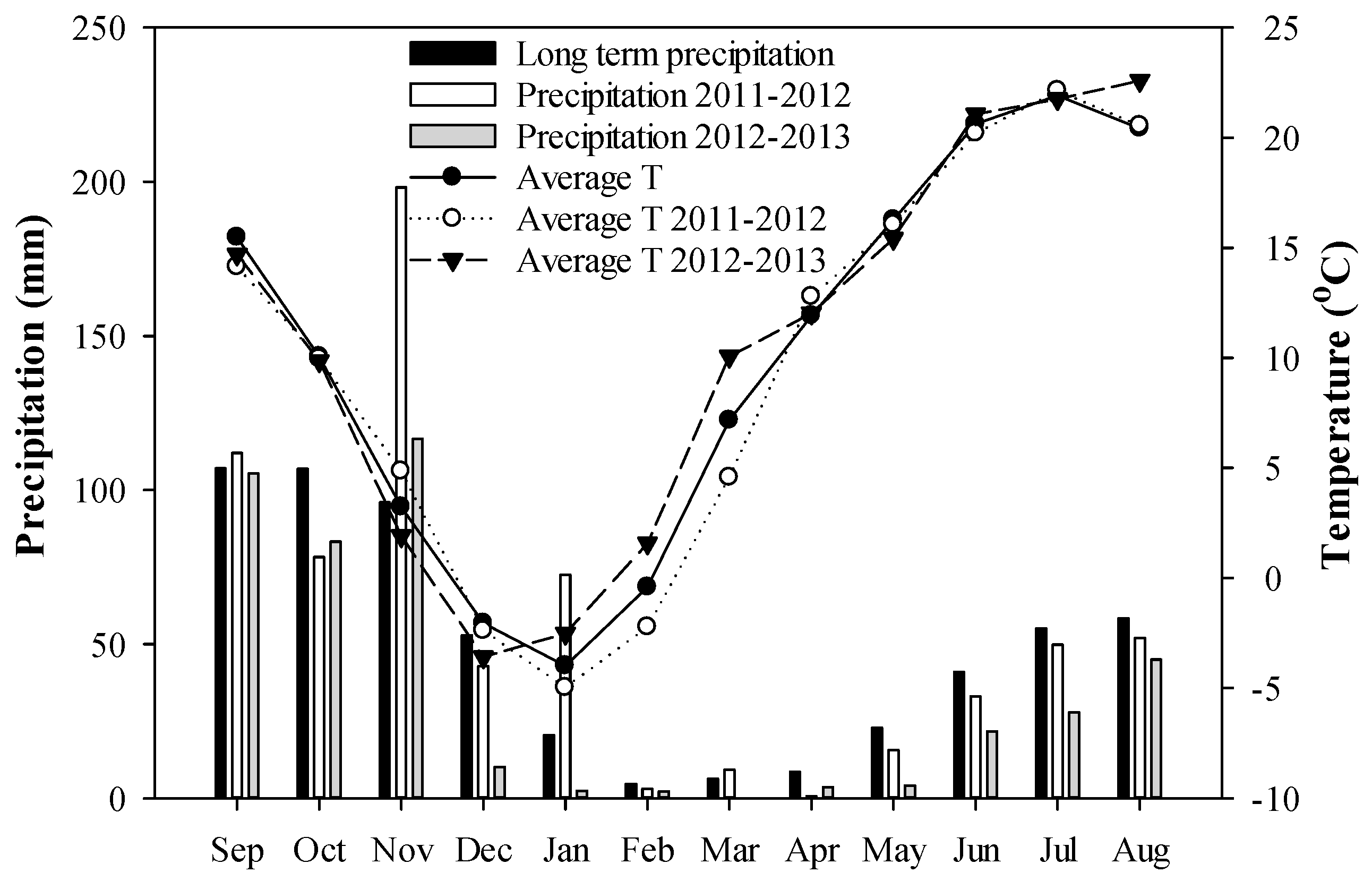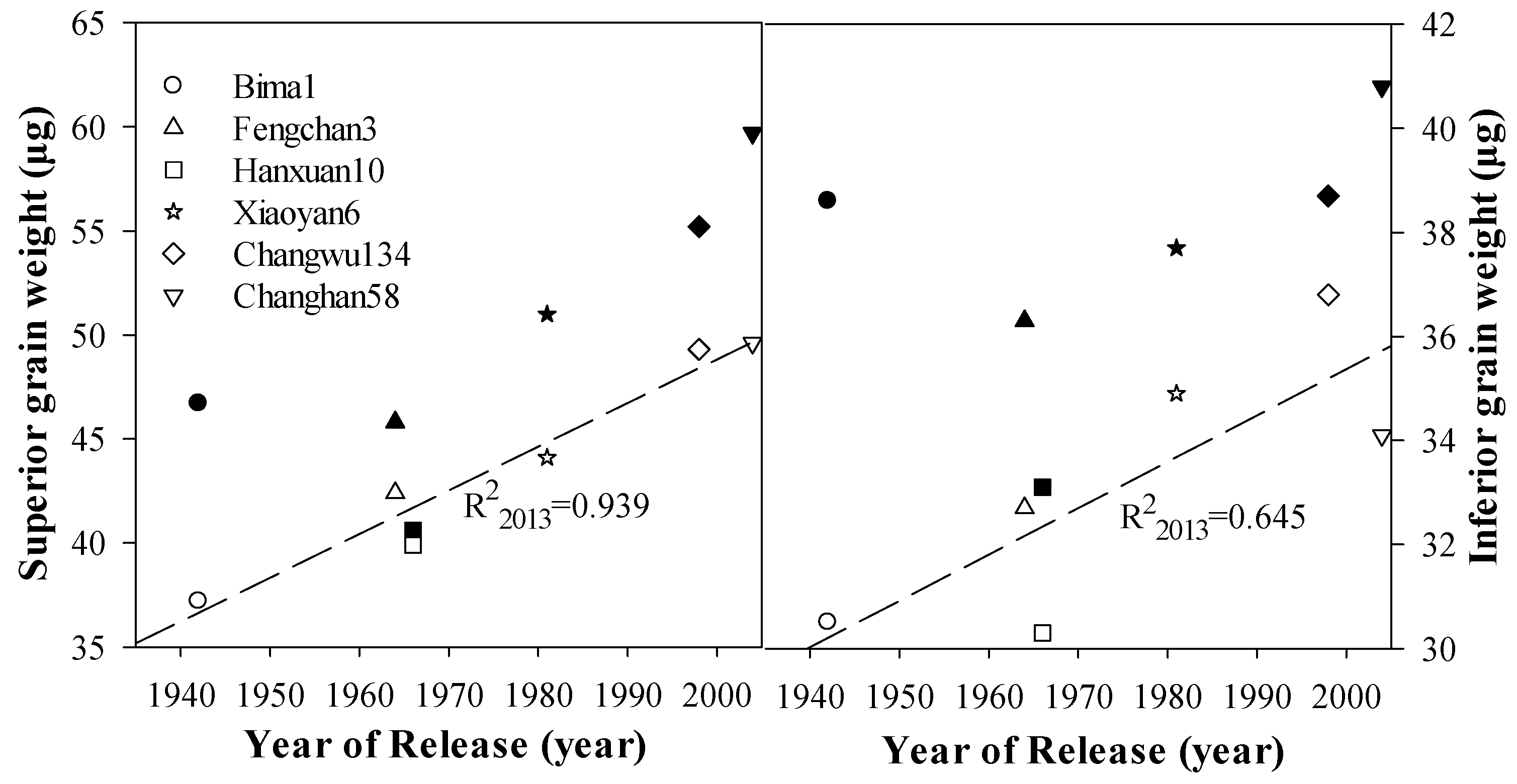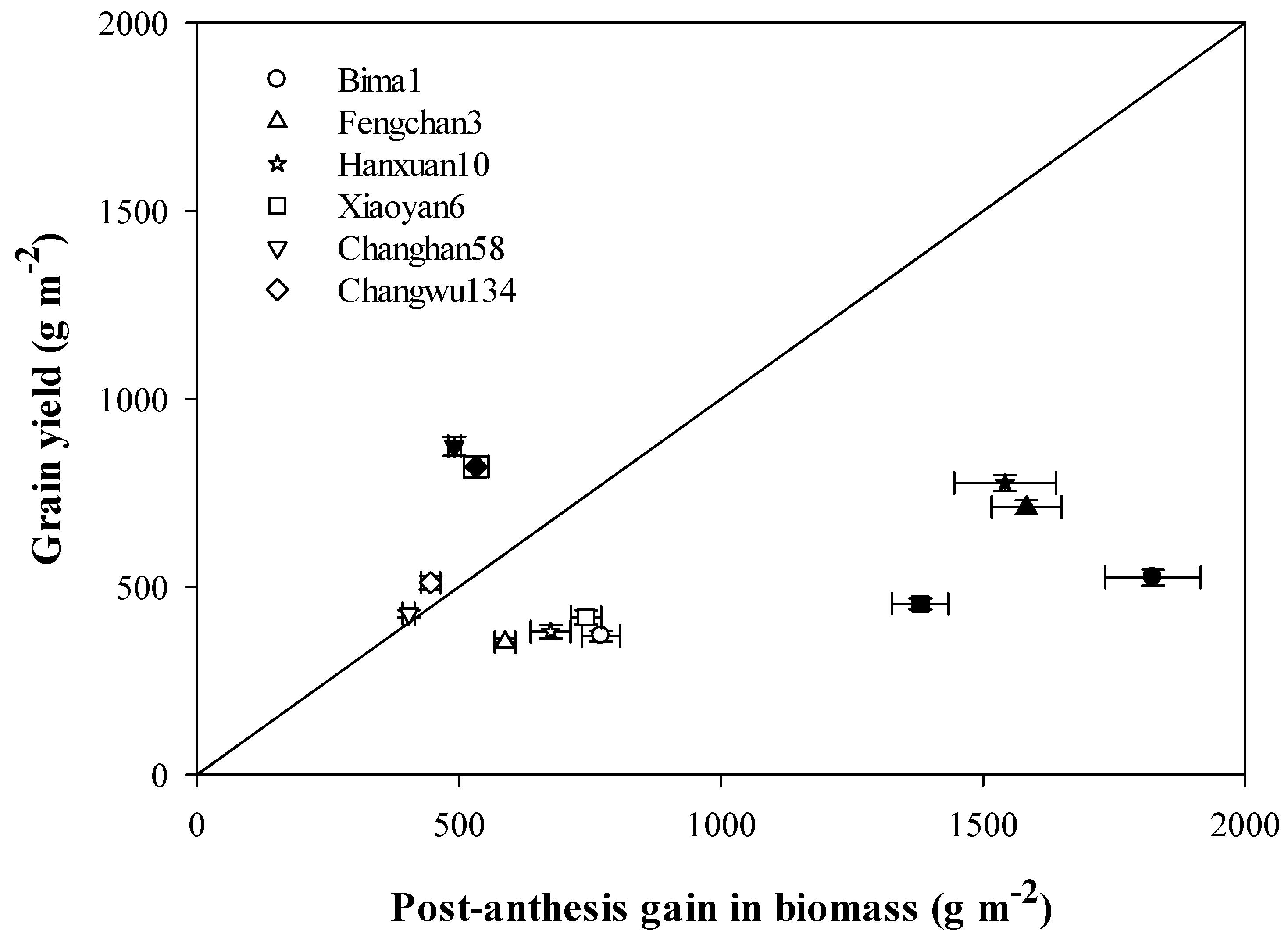The Proportion of Superior Grains and the Sink Strength are the Main Yield Contributors in Modern Winter Wheat Varieties Grown in the Loess Plateau of China
Abstract
:1. Introduction
2. Material and Methods
2.1. Location and Site Description
2.2. Plant Material
2.3. Experimental Design and Crop Management
2.4. Sampling and Measurements
2.5. Drought Index
2.6. Statistical Analysis
3. Results
3.1. Seasonal Conditions
3.2. Phenology
3.3. Plant Height
3.4. Grain Yield, Aboveground Biomass and Harvest Index
3.5. Yield Components
3.6. Remobilized Dry Matter
4. Discussion
5. Conclusions
Author Contributions
Funding
Acknowledgments
Conflicts of Interest
Abbreviations
References
- Shearman, V.J.; Sylvesterbradley, R.; Scott, R.K.; Foulkes, M.J. Physiological processes associated with wheat yield progress in the UK. Crop Sci. 2005, 45, 175–185. [Google Scholar] [CrossRef]
- Brancourt-Hulmel, M.; Doussinault, G.; Lecomte, C.; Bérard, P.; Buanec, B.L.; Trottet, M. Genetic improvement of agronomic traits of winter wheat cultivars released in France from 1946 to 1992. Crop Sci. 2003, 43, 37–45. [Google Scholar] [CrossRef]
- Graybosch, R.A.; Peterson, C.J. Genetic improvement in winter wheat yields in the Great Plains of North America, 1959–2008. Crop Sci. 2010, 50, 1882–1890. [Google Scholar] [CrossRef]
- Keser, M.; Gummadov, N.; Akin, B.; Belen, S.; Mert, Z.; Taner, S.; Topal, A.; Yazar, S.; Morgounov, A.; Sharma, R.C.; et al. Genetic gains in wheat in Turkey: Winter wheat for dryland conditions. Crop J. 2017, 5, 533–540. [Google Scholar] [CrossRef]
- Sadras, V.O.; Lawson, C. Genetic gain in yield and associated changes in phenotype, trait plasticity and competitive ability of South Australian wheat varieties released between 1958 and 2007. Crop Pasture Sci. 2011, 62, 533–549. [Google Scholar] [CrossRef]
- Lo Valvo, P.J.; Miralles, D.J.; Serrago, R.A. Genetic progress in Argentine bread wheat varieties released between 1918 and 2011: Changes in physiological and numerical yield components. Field Crop. Res. 2017, 221, 314–321. [Google Scholar] [CrossRef]
- Laidig, F.; Piepho, H.P.; Drobek, T.; Meyer, U. Genetic and non-genetic long-term trends of 12 different crops in German official variety performance trials and on-farm yield trends. Theor. Appl. Genet. 2014, 127, 2599–2617. [Google Scholar] [CrossRef] [Green Version]
- Qin, X.L.; Zhang, F.X.; Liu, C.; Yu, H.; Cao, B.G.; Tian, S.Q.; Liao, Y.C.; Siddique, K.H.M. Wheat yield improvements in China: Past trends and future directions. Field Crop. Res. 2015, 177, 117–124. [Google Scholar] [CrossRef]
- Tian, Z.W.; Qi, J.; Dai, T.B.; Dong, J.; Cao, W.X. Effects of genetic improvements on grain yield and agronomic traits of winter wheat in the Yangtze River Basin of China. Field Crop. Res. 2011, 124, 417–425. [Google Scholar] [CrossRef]
- Xiao, Y.G.; Qian, Z.G.; Wu, K.; Liu, J.J.; Xia, X.C.; Ji, W.Q.; He, Z.H. Genetic gains in grain yield and physiological traits of winter wheat in Shandong Province, China, from 1969 to 2006. Crop Sci. 2012, 52, 44–56. [Google Scholar] [CrossRef]
- Sun, Y.Y.; Wang, X.L.; Wang, N.; Chen, Y.L.; Zhang, S.Q. Changes in the yield and associated photosynthetic traits of dry-land winter wheat (Triticum aestivum L.) from the 1940s to the 2010s in Shaanxi Province of China. Field Crop. Res. 2014, 167, 1–10. [Google Scholar] [CrossRef]
- Gao, F.; Ma, D.; Yin, G.; Rasheed, A.; Dong, Y.; Xiao, Y.; Xia, X.; Wu, X.; He, Z. Genetic progress in grain yield and physiological traits in Chinese wheat cultivars of Southern Yellow and Huai valley winter wheat zone since 1950. Crop Sci. 2017, 57, 760–773. [Google Scholar] [CrossRef]
- Zhao, Y.; Liu, X.H.; Sun, T.D. Prediction of Chinese arable land based on SAR Model. J. Arid Land Resour. Environ. 2013, 27, 1–5, (In Chinese with English abstract). [Google Scholar]
- Turner, N.C.; Molyneux, N.; Yang, S.; Xiong, Y.C.; Siddique, K.H. Climate change in south-west Australia and north-west China: Challenges and opportunities for crop production. Crop Pasture Sci. 2011, 62, 445–456. [Google Scholar] [CrossRef]
- Wang, X.C.; Li, J. Evaluation of crop yield and soil water estimates using the EPIC model for the Loess Plateau of China. Math. Comput. Modell. 2010, 51, 1390–1397. [Google Scholar] [CrossRef]
- Ding, D.Y.; Feng, H.; Zhao, Y.; He, J.Q.; Zou, Y.F.; Jin, J.M. Modifying winter wheat sowing date as an adaptation to climate change on the Loess Plateau. Agron. J. 2015, 108, 53–63. [Google Scholar] [CrossRef]
- Xin, Z.; Yu, X.; Li, Q.; Lu, X.X. Spatiotemporal variation in rainfall erosivity on the Chinese Loess Plateau during the period 1956–2008. Reg. Environ. Chang. 2011, 11, 149–159. [Google Scholar] [CrossRef]
- Jiang, D.; Cao, W.X.; Dai, T.B.; Jing, Q. Activities of key enzymes for starch synthesis in relation to growth of superior and inferior grains on winter wheat (Triticum aestivum L.) spike. Plant Growth Regul. 2003, 41, 247–257. [Google Scholar] [CrossRef]
- Yong, L.; Cui, Z.; Ni, Y.; Zheng, M.; Yang, D.; Min, J.; Jin, C.; Wang, Z.; Yin, Y. Plant density effect on grain number and weight of two winter wheat cultivars at different spikelet and grain positions. PLoS ONE 2016, 11, e0155351. [Google Scholar] [CrossRef]
- Acreche, M.M.; Slafer, G.A. Grain weight response to increases in number of grains in wheat in a Mediterranean area. Field Crop. Res. 2006, 98, 52–59. [Google Scholar] [CrossRef]
- Zhang, C.; Jiang, D.; Liu, F.; Cai, J.; Dai, T.; Cao, W. Starch granules size distribution in superior and inferior grains of wheat is related to enzyme activities and their gene expressions during grain filling. J. Cereal Sci. 2010, 51, 226–233. [Google Scholar] [CrossRef]
- Yang, J.C.; Zhang, J.H. Grain filling of cereals under soil drying. New Phytol. 2006, 169, 223–236. [Google Scholar] [CrossRef] [PubMed]
- Yang, J.; Zhang, J.; Liu, K.; Wang, Z.; Liu, L. Abscisic acid and ethylene interact in wheat grains in response to soil drying during grain filling. New Phytol. 2006, 171, 293–303. [Google Scholar] [CrossRef]
- Yang, J.; Zhang, J. Grain-filling problem in ‘super’ rice. J. Exp. Bot. 2010, 61, 1–5. [Google Scholar] [CrossRef] [PubMed]
- Yu, A.; Li, Y.; Ni, Y.; Yang, W.; Yang, D.; Cui, Z.; Wang, Z.; Yin, Y. Differences of starch granule distribution in grains from different spikelet positions in winter wheat. PLoS ONE 2014, 9, e114342. [Google Scholar] [CrossRef] [PubMed]
- Yang, J.C.; Zhang, J.H.; Wang, Z.Q.; Liu, K.; Wang, P. Post-anthesis development of inferior and superior spikelets in rice in relation to abscisic acid and ethylene. J. Exp. Bot. 2006, 57, 149–160. [Google Scholar] [CrossRef]
- Zhang, Y.; Xu, W.G.; Wang, H.W.; Dong, H.B.; Qi, X.L.; Zhao, M.Z.; Fang, Y.H.; Gao, C.; Hu, L. Progress in genetic improvement of grain yield and related physiological traits of Chinese wheat in Henan Province. Field Crop. Res. 2016, 199, 117–128. [Google Scholar] [CrossRef]
- Zheng, T.C.; Zhang, X.K.; Yin, G.H.; Wang, L.N.; Han, Y.L.; Chen, L.; Huang, F.; Tang, J.W.; Xia, X.C.; He, Z.H. Genetic gains in grain yield, net photosynthesis and stomatal conductance achieved in Henan Province of China between 1981 and 2008. Field Crop. Res. 2011, 122, 225–233. [Google Scholar] [CrossRef]
- Sanchez-Garcia, M.; Royo, C.; Aparicio, N.; Martín-Sánchez, J.A.; Alvaro, F. Genetic improvement of bread wheat yield and associated traits in Spain during the 20th century. J. Agric. Sci. 2013, 151, 105–118. [Google Scholar] [CrossRef]
- Blum, A.; Mayer, J.; Golan, G. The effect of grain number per ear (sink size) on source activity and its water-relations in wheat. J. Exp. Bot. 1988, 39, 106–114. [Google Scholar] [CrossRef]
- Cartelle, J.; Pedro, A.; Savin, R.; Slafer, G.A. Grain weight responses to post-anthesis spikelet-trimming in an old and a modern wheat under Mediterranean conditions. Eur. J. Agron. 2006, 25, 365–371. [Google Scholar] [CrossRef]
- González, F.G.; Aldabe, M.L.; Terrile, I.I.; Rondanini, D.P. Grain weight response to different postflowering source: Sink ratios in modern high-yielding Argentinean wheats differing in spike fruiting efficiency. Crop Sci. 2014, 54, 297–309. [Google Scholar] [CrossRef]
- Slafer, G.A.; Miralles, D.J. Fruiting efficiency in three bread wheat (Triticum aestivum) cultivars released at different eras. Number of grains per spike and grain weight. J. Agron. Crop Sci. 1993, 170, 251–260. [Google Scholar] [CrossRef]
- Miralles, D.J.; Slafer, G.A. Individual grain weight responses to genetic reduction in culm length in wheat as affected by source-sink manipulations. Field Crop. Res. 1995, 43, 55–66. [Google Scholar] [CrossRef]
- Feng, F.; Han, Y.; Wang, S.; Yin, S.; Peng, Z.; Zhou, M.; Gao, W.; Wen, X.; Qin, X.; Siddique, K.H.M. The effect of grain position on genetic improvement of grain number and thousand grain weight in winter wheat in North China. Front. Plant Sci. 2018, 9, 129. [Google Scholar] [CrossRef] [PubMed]
- Zhang, H.P.; Turner, N.C.; Poole, M.L. Source–sink balance and manipulating sink–source relations of wheat indicate that the yield potential of wheat is sink-limited in high-rainfall zones. Crop Pasture Sci. 2010, 61, 852–861. [Google Scholar] [CrossRef]
- Borras, L.; Slafer, G.A.; Otegui, M.E. Seed dry weight response to source-sink manipulations in wheat, maize and soybean: A quantitative reappraisal. Field Crop. Res. 2004, 86, 131–146. [Google Scholar] [CrossRef]
- Asseng, S.; Kassie, B.T.; Labra, M.H.; Amador, C.; Calderini, D.F. Simulating the impact of source-sink manipulations in wheat. Field Crop. Res. 2016, 202, 47–56. [Google Scholar] [CrossRef]
- Lawlor, D.W.; Paul, M.J. Source/sink interactions underpin crop yield: The case for trehalose 6-phosphate/SnRK1 in improvement of wheat. Front. Plant Sci. 2014, 5, 418. [Google Scholar] [CrossRef]
- Reynolds, M.; Foulkes, J.; Furbank, R.T.; Griffiths, S.; King, J.; Murchie, E.; Parry, M.A.; Slafer, G.A. Achieving yield gains in wheat. Plant Cell Environ. 2012, 35, 1799–1823. [Google Scholar] [CrossRef]
- Gong, Z.; Zhang, G.; Chen, Z. Pedogenesis and Soil Taxonomy; Beijing Science Press Publishing: Beijing, China, 2007. (In Chinese) [Google Scholar]
- Hanft, J.M.; Wych, R.D. Visual indicators of physiological maturity of hard red spring wheat. Crop Sci. 1982, 22, 584–588. [Google Scholar] [CrossRef]
- Zadoks, J.C.; Chang, T.T.; Konzak, C.F. A decimal code for the growth stages of cereals. Weed Res. 1974, 14, 415–421. [Google Scholar] [CrossRef]
- Kobata, T.; Palta, J.A.; Turner, N.C. Rate of development of postanthesis water deficits and grain filling of spring wheat. Crop Sci. 1992, 32, 1238–1242. [Google Scholar] [CrossRef]
- Palta, J.A.; Fillery, I. N application increases pre-anthesis contribution of dry matter to grain yield in wheat grown on a duplex soil. Aust. J Agr. Res. 1995, 46, 507–518. [Google Scholar] [CrossRef]
- Takami, S.; Kobata, T.; Bavel, C.H.M.V. Quantitative method for analysis of grain yield in rice. Agron. J. 1990, 82, 1149–1153. [Google Scholar] [CrossRef]
- Guo, S.; Zhu, H.; Dang, T.; Wu, J.; Liu, W.; Hao, M.; Li, Y.; Syers, J.K. Winter wheat grain yield associated with precipitation distribution under long-term nitrogen fertilization in the semiarid Loess Plateau in China. Geoderma 2012, 189–190, 442–450. [Google Scholar] [CrossRef]
- Xing, N.Q.; Zhang, Y.Q.; Wang, L.X. The Study on Dryland Agriculture in North China; Chinese Agriculture Press: Beijing, China, 2002. [Google Scholar]
- Fang, Y.; Du, Y.; Wang, J.; Wu, A.; Qiao, S.; Xu, B.; Zhang, S.; Siddique, K.H.M.; Chen, Y. Moderate drought stress affected root growth and grain yield in old, modern and newly released cultivars of winter wheat. Front. Plant Sci. 2017, 8, 672. [Google Scholar] [CrossRef]
- Wang, Q.X.; Wang, M.B.; Fan, X.H.; Feng, Z.; Zhu, S.Z.; Zhao, T.L. Trends of temperature and precipitation extremes in the Loess Plateau Region of China, 1961–2010. Theor. Appl. Climatol. 2016, 92–93, 949–963. [Google Scholar] [CrossRef]
- Kahiluoto, H.; Kaseva, J.; Balek, J.; Olesen, J.E.; Ruiz-Ramos, M.; Gobin, A.; Kersebaum, K.C.; Takáč, J.; Ruget, F.; Ferrise, R.; et al. Decline in climate resilience of European wheat. Proc. Natl. Acad. Sci. USA 2019, 116, 123–128. [Google Scholar] [CrossRef]
- Ehdaie, B.; Alloush, G.A.; Madore, M.A.; Waines, J.G. Genotypic variation for stem reserves and mobilization in wheat: I. Postanthesis changes in internode dry matter. Crop Sci. 2006, 46, 735–746. [Google Scholar] [CrossRef]
- Austin, R.B.; Bingham, J.; Blackwell, R.D.; Evans, L.T.; Ford, M.A.; Morgan, C.L.; Taylor, M. Genetic improvements in winter wheat yields since 1900 and associated physiological changes. J. Agric. Sci. 1980, 94, 675–689. [Google Scholar] [CrossRef]
- Flintham, J.E.; Börner, A.; Worland, A.J.; Gale, M.D. Optimizing wheat grain yield: Effects of Rht (gibberellin-insensitive) dwarfing genes. J. Agric. Sci. 1997, 128, 11–25. [Google Scholar] [CrossRef]
- Parry, M.; Reynolds, M.; Salvucci, M.; Raines, C.; Andralojc, P.; Zhu, X.; Price, G.; Condon, A.; Furbank, R. Raising yield potential of wheat. II. Increasing photosynthetic capacity and efficiency. J. Exp. Bot. 2011, 62, 453–467. [Google Scholar] [CrossRef] [PubMed]
- Chen, X.; Hao, M.D. Low contribution of photosynthesis and water-use efficiency to improvement of grain yield in Chinese wheat. Photosynthetica 2015, 53, 519–526. [Google Scholar] [CrossRef]
- Youssefian, S.; Kirby, E.J.M.; Gale, M.D. Pleiotropic effects of the GA-insensitive Rht dwarfing genes in wheat. 2. Effects on leaf, stem, ear and floret growth. Field Crop. Res. 1992, 28, 191–210. [Google Scholar] [CrossRef]
- Deng, X.P.; Shan, L.; Zhang, H.P.; Turner, N.C. Improving agricultural water use efficiency in arid and semiarid areas of China. Agr. Water Manag. 2006, 80, 23–40. [Google Scholar] [CrossRef]
- Evans, L.T. Crop Evolution, Adaptation and Yield; Cambridge University Press: Cambridge, UK, 1993; pp. 133–142. [Google Scholar]
- Liang, W.; Zhang, Z.; Wen, X.; Liao, Y.; Yang, L. Effect of non-structural carbohydrate accumulation in the stem pre-anthesis on grain filling of wheat inferior grain. Field Crop. Res. 2017, 211, 66–76. [Google Scholar] [CrossRef]
- Dreccer, M.F.; Herwaarden, A.F.V.; Chapman, S.C. Grain number and grain weight in wheat lines contrasting for stem water soluble carbohydrate concentration. Field Crop. Res. 2009, 112, 43–54. [Google Scholar] [CrossRef]
- Yang, J.; Zhang, J.; Wang, Z.; Xu, G.; Zhu, Q. Activities of key enzymes in sucrose-to-starch conversion in wheat grains subjected to water deficit during grain filling. Plant Physiol. 2004, 135, 1621–1629. [Google Scholar] [CrossRef]
- Chen, J.; Tian, Y.; Zhang, X.; Zheng, C.; Song, Z.; Deng, A.; Zhang, W. Nighttime warming will increase winter wheat yield through improving plant development and grain growth in north China. J. Plant Growth Regul. 2014, 33, 397–407. [Google Scholar] [CrossRef]
- Reynolds, M.; Bonnett, D.; Chapman, S.C.; Furbank, R.T.; Manès, Y.; Mather, D.E.; Parry, M.A.J. Raising yield potential of wheat. I. Overview of a consortium approach and breeding strategies. J. Exp. Bot. 2011, 62, 439–452. [Google Scholar] [CrossRef] [PubMed]











| Variety | Time of Release | Decade of Main Plant | Dwarfing Gene | Characteristics |
|---|---|---|---|---|
| Bima1 | 1942 | 1950s | None | Lodging Resistance |
| Fengchan3 | 1964 | 1960s | None | Resistance to stripe rust |
| Hanxuan10 | 1966 | 1970s | None | Drought resistance |
| Xiaoyan6 | 1981 | 1980s | Rht-B1b+Rht8 | Resistance to stripe rust |
| Changwu134 | 1998 | 1990s | Rht-B1b | Drought resistance |
| Changhan58 | 2004 | 2000s | Rht-B1b | Drought resistance |
| Variety | 2011–2012 | 2012–2013 | ||||
|---|---|---|---|---|---|---|
| Anthesis (DAS) | Maturity (DAS) | Duration Grain Filling (d) | Anthesis (DAS) | Maturity (DAS) | Duration Grain Filling (d) | |
| Bima1 | 230 | 269 | 39 | 226 | 261 | 35 |
| Fengchan3 | 233 | 272 | 39 | 230 | 266a | 36 |
| Hanxuan10 | 230 | 269 | 39 | 227 | 264 | 37 |
| Xiaoyan6 | 231 | 271 | 40 | 230 | 268 | 38 |
| Changwu134 | 231 | 273 | 42 | 230 | 268 | 38 |
| Changhan58 | 232 | 275 | 43 | 231 | 271 | 40 |
| LSD0.05 | 1.6 | 2.8 | 2.7 | 1.3 | 2.0 | 2.8 |
| Variety | SN (Spikes m−2) | GN (Grains m−2) | GNS (Grains Spike−1) | |||
|---|---|---|---|---|---|---|
| 2011–2012 | 2012–2013 | 2011–2012 | 2012–2013 | 2011–2012 | 2012–2013 | |
| Bima1 | 756 b | 606 a | 20041 b | 11020 c | 26.5 c | 23.1 c |
| Fengchan3 | 765 b | 424 c | 24849 a | 13148 a | 32.5 b | 28.7 c |
| Hanxuan10 | 703 c | 577 a | 16992 c | 13091 a | 23.3 c | 22.0 c |
| Xiaoyan6 | 833 a | 406 c | 24788 a | 12368 b | 34.9 a | 30.7 b |
| Changwu134 | 700 c | 519 b | 22441 a | 13108 a | 32.1 b | 25.5 c |
| Changhan58 | 619 d | 399 d | 23893 a | 13752 a | 38.6 a | 34.2 a |
| Mean | 729 | 489 | 22167 | 12748 | 31.3 | 27.4 |
© 2019 by the authors. Licensee MDPI, Basel, Switzerland. This article is an open access article distributed under the terms and conditions of the Creative Commons Attribution (CC BY) license (http://creativecommons.org/licenses/by/4.0/).
Share and Cite
Chen, W.; Sun, Y.; Zhang, S.; Palta, J.A.; Deng, X. The Proportion of Superior Grains and the Sink Strength are the Main Yield Contributors in Modern Winter Wheat Varieties Grown in the Loess Plateau of China. Agronomy 2019, 9, 612. https://doi.org/10.3390/agronomy9100612
Chen W, Sun Y, Zhang S, Palta JA, Deng X. The Proportion of Superior Grains and the Sink Strength are the Main Yield Contributors in Modern Winter Wheat Varieties Grown in the Loess Plateau of China. Agronomy. 2019; 9(10):612. https://doi.org/10.3390/agronomy9100612
Chicago/Turabian StyleChen, Wei, Yingying Sun, Suiqi Zhang, Jairo A. Palta, and Xiping Deng. 2019. "The Proportion of Superior Grains and the Sink Strength are the Main Yield Contributors in Modern Winter Wheat Varieties Grown in the Loess Plateau of China" Agronomy 9, no. 10: 612. https://doi.org/10.3390/agronomy9100612






